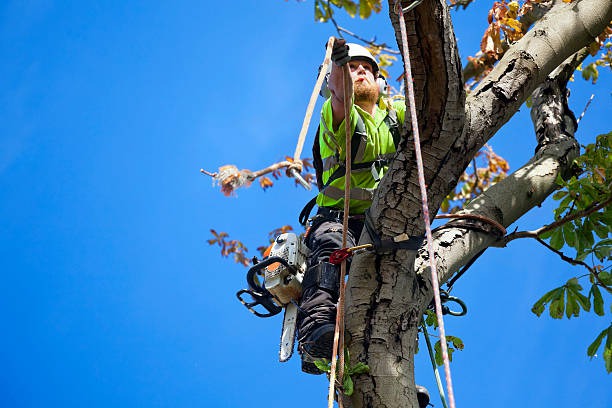It’s easy to overlook the trees on your property, but ignoring a potentially unstable tree can lead to serious consequences. Unstable trees pose risks not only to your property but also to your safety and the safety of others. Fallen branches or an entire tree collapse can damage your home, vehicles, or even nearby power lines. By recognizing these risks, you can take proactive steps to manage unstable trees effectively.
1. Signs of an Unstable Tree
Knowing what to look for is the first step in assessing tree stability. Here are some common signs that a tree may be unstable:
-
Leaning or lopsided appearance
-
Cracks in the trunk or large branches
-
Dead or falling branches
-
Roots visible above ground or signs of root damage
-
Fungal growth at the base or on the trunk
2. Regular Inspections and Monitoring
Scheduling regular inspections with a professional arborist can help detect potential hazards before they become emergencies. Even if a tree appears healthy, underlying issues may not be visible to an untrained eye.
Why Regular Checks Matter
Trees can be unpredictable, particularly during storms or high winds. Regular checks ensure that any changes in a tree’s condition are documented and addressed promptly. They provide peace of mind by uncovering problems like pest infestations, disease, or structural weaknesses early on.
3. Practical Methods for Tree Stabilization
Sometimes, it’s possible to stabilize a tree instead of removing it.
Cabling and Bracing
Cabling and bracing involve reinforcing the tree’s structure using rods and cables. This method can help support weak branches and reduce stress during high winds.
How It Works
This technique is carried out by a trained professional who installs flexible steel cables or rods to redistribute mechanical stress among branches. It’s often used for trees with multiple trunks or a high risk of splitting.
4. Clearing Hazards Around Trees
Once you’ve decided how to handle an unstable tree, it’s vital to address other safety concerns in the area. Keeping the area around your tree clear of debris can prevent accidents and further damage.
Creating a Safe Perimeter
By maintaining a safe perimeter, you can control debris accumulation that might otherwise contribute to instability. Keeping your tree and its surroundings clean is crucial for ensuring ongoing safety. Engaging in brush clearance in San Luis Obispo can further eliminate risks posed by nearby undergrowth.
5. When Tree Removal Becomes Necessary
Although it’s often preferable to save a tree, removal sometimes becomes the best option. Whether it’s due to extensive damage, disease, or a high risk of collapse, tree removal is a decision that shouldn’t be taken lightly.
Deciding on Tree Removal
Before proceeding with tree removal, consult with an arborist to assess the tree’s condition and explore any alternatives. An expert opinion ensures you make an informed choice.
Getting Professional Help
If removal becomes necessary, it’s crucial to hire professionals to handle the job. They have the expertise and equipment to remove trees safely and efficiently, minimizing damage to your property.
6. Handling Tree Debris and Waste
Once a tree is removed, dealing with the leftover debris is the next challenge.
Eco-Friendly Disposal Options
Disposing of tree waste responsibly is critical. Consider these eco-friendly options:
-
Composting smaller branches and leaves
-
Using a chipper to create mulch for landscaping
-
Repurposing large sections of the trunk
Wood milling in San Luis Obispo turns tree waste into valuable materials like planks and beams, giving your removed tree a second life in beautifully crafted wooden items.
7. Preventive Measures for Future Safety
Once you’ve adequately managed existing issues, consider implementing preventive measures to avoid future problems.
Planting the Right Trees
Selecting the right species and planting them strategically can reduce risk. Opt for native species known to withstand local conditions and avoid planting large trees too close to structures.
Regular Pruning
Effective pruning promotes healthy growth and prevents limbs from becoming too heavy. Regular maintenance by a trained arborist can significantly improve the safety and appearance of your trees.
8. Using Emergency Services
Sometimes, despite your best efforts, an unexpected storm or accident may necessitate immediate action. In such scenarios, having access to quick, reliable services becomes crucial.
Seeking Professional Help in Emergencies
Knowing when and how to contact an emergency tree service in San Luis Obispo can make all the difference when you’re dealing with a sudden tree crisis. It ensures that emergencies are managed with minimal stress and disruption.
9. Creating a Long-term Maintenance Plan
Maintaining the balance between enjoying your trees and ensuring safety involves a long-term commitment.
Documenting and Scheduling
Keep a detailed record of all inspections, treatments, and services performed on your trees. Scheduling regular checks and maintenance ensures ongoing monitoring and landmarking issues if they arise.
Final Thoughts
Trees bring beauty and shade to your property, but they come with responsibilities. By understanding and managing unstable trees, you’ll not only protect your home and loved ones but also sustain the health and beauty of your property. Whether through preventive measures or professional help, taking action is key to ensuring the safety and stability of the trees in your care.


